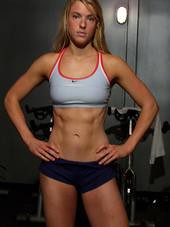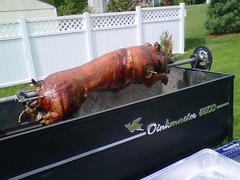In case you missed it yesterday, HERE is part I of the interview I did with strength athlete (and resident pink dumbbell poo-poo’er), Molly Galbraith. If you’re too lazy to click on the link to play catch up, I can give you the Cliff Notes version here:
Figure shows, blah blah blah blah, un-explained weight gain, yada yada yada, diagnosed with rare disease which made competiing in figure no longer feasable, blibbidy blah blibbidy bloo, switched to lifting heavy things, so on and so forth, pulled close to 350 lbs in competition, pissed excellence all over the place, made random guys have to manually unclench their butt cheeks when they watched her train, still looks like a girl, Tony Gentilcore is the greatest thing since sliced bread, and that’s about it!
Okay, there’s definitely a lot more to it than that, but I highly encourage you to click on the link above to get caught up.
So yesterday we ended with Molly telling a story of when she pwned some guy in the weightroom. I don’t know about you, but I LIVE for stories like that. It always cracks me up when guys walk around with their chest puffing out as if that 225 lb deadlift they just did for five (atrocious) reps was some kind of big deal; then skoffs when a girl walks into the free weight area – only to be completely dominated.
Anyways, today, we’re going to pick up with Molly going into a little more detail on her training as well as some of her pet peeves when it comes to the stigma of women lifting heavy weight.
BUT – before we begin, here’s an interesting aside. In case people don’t read all the way to end, I felt it was important to include this part in the beginning: Below is an email I receieved from Molly yesterday afternoon:
You know what I just thought about and I am actually kind of scared that you’llsay yes… do you want some of my fat pictures? I have some fatty pictures from 2004 that I took as my “before” pictures. It might actually help drive home the point that if you lift heavy and watch your diet… you will SHRINK! What do you think? Maybe have a before and after at the end? Let me know!
Of course, I said yes, and Molly was kind enough to send them along.
Before lifting heavy things off the ground (2004)
185 lbs
approx. 34% body fat
~63 lbs of fat
~122 lbs of lean mass

After lifting heavy things for 7+ years (2011)
167 lbs
approx. 16.1% body fat (taken via Bod Pod 3 weeks ago)
~27 lbs of fat
~140 lbs of lean mass

So even though the scale shows less than a 20 lb weight loss, Molly actually lost over 35 lbs of fat and added almost 20 lbs of muscle…but completely transformed her body in the process. Still think scale weight means ANYTHING in terms of progress? Ladies, throw away your scale!
Okay, enough of the small talk.
TG: So, I know everyone’s dying to hear what your training looks like nowadays………spill it!
MG: My schedule is kind of wacky right now so I have to fit my training in when I can, which is typically 3 days a week, occasionally 4 if I’m lucky. The program Mike [Robertson] has written for me currently is a 4 day split (2 upper body days, 2 lower body days). Each day starts with one of the following: squat, barbell bench press, deadlift, or dumbbell bench press. Right now I am training those movements in the 3-8 rep range depending on the week.
After the main movement comes my accessory work. My glutes, hamstrings, triceps and anterior core are all pretty weak so a lot of my accessory movements focus on bringing those areas up… but it’s nothing magic… just simple stuff that works. I do good mornings, Romanian deadlifts, lunges, chins, face pulls, glute ham raises, close grip bench press, tricep pressdowns, Pallof presses, band resisted jackknives, GHR, etc.
Sometimes after an upper body day I will throw in some Battling Rope work for 5-10 minutes and after my lower body day I might do some swings or prowler pushes but I don’t do a ton of conditioning. Maybe 2-3 days a week for 5-10 minutes? I let my strength training and my diet keep me relatively lean and since I still battle fatigue at times I like to save my energy for throwing around heavy stuff. Because heavy things aren’t going to lift themselves… right, Tony? 😉
TG: I’m picking up what you’re putting down. I get it. High five!
MG: Oh, and I guess I should mention that I do quite a bit of foam rolling and mobility work before I lift to help keep me healthy and safe. In the past I designed a lot of my own training programs, but it’s hard to be objective and make yourself do things you suck at. That’s one of the reasons that I think having a Coach is so important no matter how much you know about training.
In fact, my friend Jim was interviewing Dan John recently and he was talking about his Coach. I mean come on! If Dan John has a freaking Coach, chances are that you need one too!
If for some reason you can’t afford one or there isn’t a good one in your area, there are some great training program templates out there like my own redpointfitness.com, DeFranco’s Westside for Skinny Bastards, Wendler’s 5/3/1, Nia Shanks’ Fat Loss Detour, or Cressey’s Show and Go. Just make sure you are constantly trying to improve your weaknesses. It’s hard to go wrong if you do that. But also throw in some stuff you enjoy and are good at. Training is supposed to be fun!
TG: So um, yeah, there are a ton of women out there who are intimidated by lifting heavy weight – for fear of getting “too big a bulky,” and silly stuff like that. Can you share some insights on why you feel this is an absolutely retarded way of thinking?
MG: Haha! Well with all due respect Tony, I think the quickest way to get someone to shut you out and quit listening to you completely is to tell them that one of their deepest core beliefs that has been ingrained in them all their life is retarded… BUT it is definitely a major myth that I REALLY want to dispel with women. =)
TG: Okay, okay. To be more politically correct, can you elaborate on why this line of thinking is archaic nonsense aaaaaaaand, dammit, I can’t help it……. it’s retarded!
MG: There are numerous reasons why women believe this to begin with, which is a whole ‘nother article in itself… but I have found that there are a couple of good ways to help women see the light. The first is to actually listen to what they have to say. When they tell you that they are afraid they will get bulky… ask them why. Often times it’s because they have started weight training in the past without changing their diets (or sometimes eating more because they “deserve” it or they are simply hungrier because of the energy they are expending). So they may have added muscle without losing any body fat or they may have even gained body fat… so they added something without losing anything. OF COURSE they got bigger!
They also may have seen images of female bodybuilders on TV or in magazines and they don’t have the reference point to understand that those women are often on LOTS of drugs and have been training for decades to look the way that they look.
Heck, they may have even just read it in silly magazines or heard a ridiculously uninformed “trainer” talk about lifting making you bulky. The truth is 99.5% of women DO NOT have the genetics to get what most would consider “big” muscles. If they do, they are probably playing sports at a D1 school or competing in bodybuilding.
If you are a woman who has started lifting weights and you feel like you are getting bulky, your best bet is to examine your diet. There are VERY, VERY few women that I know who are very lean and still have “big” muscles. Chances are most of your bulk is coming from the body fat covering your muscles.
If you clean your diet up, do intelligent cardio and keep lifting heavy… chances are you will get smaller and become more and more pleased with your body. My partner and I have several clients who lift super heavy 2-3 days a week for 45 minutes, do a little bit of conditioning and eat a decent diet and they have done nothing but shrink and get more defined!
Oh, and keep in mind that training for strength and training for size are very different ways of training once you are no longer a beginner. It is pretty easy for most women to train for pure strength and gain almost no muscular size whatsoever.
Another good way of helping women see the light in regards to strength training is to show them images of women who are strong and athletic. They are so many fit and sexy females out there who lift heavy things (and have been for years) and have incredibly feminine bodies. For a few examples check out: Jen Comas Keck, Rachel Cosgrove, Leigh Peele, Cassandra Forsythe, Nia Shanks, Candice Karnes, Rachel Guy, Neghar Fonooni, Jen Grasso, and Olesya Novik. These women have bodies that most of us would kill for and they all put up impressive numbers in the gym as well.
Finally, you have to consider that each woman has their own point of view regarding what they consider to be “bulky.” Leigh Peele actually did her own research and wrote an article about it HERE. Of the women she polled, a good chunk of them actually found JESSICA BIEL to be “BULKY!!!!!”
The funniest part is, I would bet that more than 75% of the women who said that about Jessica Biel are actually bigger than her and don’t look NEARLY as good in a bikini. Unfortunately there are some delusional people out there whose opinions you just won’t change and there is no point in wasting your time on them.
They can continue to dance around in an 80 degree room for 2 hours a day, 6 days a week twirling 3 lbs weights above their heads and doing hundreds of repetitions of weird movements using bands attached to the ceiling and eating baby food… not that I am referencing anyone in particular (::cough cough:: Tracy Anderson ::cough cough::). I am going to lift 3 days a week for an hour and eat steak and whole eggs and real butter and enjoy my strong bones and my abs. =)
TG: Now that’s what I’m talking about. Anyone who goes out of their way to mock Tracy Anderson, is cool in my book. So, with all that being said, give it to me straight – give me your top 3-5 pieces of advice for women looking to start a strength program
MG: Oh geez… just 3-5? Alright here goes nothing!
- Get assessed by a professional! So many of us have weaknesses, imbalances, tightness, etc. You can squat and deadlift and sprint all you want, but if your glutes are shut off because your hip flexors are too tight… your booty won’t look any better no matter what you do! This also helps prevent injury, improves posture, reduces/eliminates aches and pains, etc. If you can’t afford an assessment or don’t know of anyone in your area, get the Assess and Correct manual and follow it! You will be glad you did!
- Get strong first! Until you can properly squat and deadlift at least your body weight for females and bench press at least half your body weight for females, you have no business doing body part splits or any other training for that matter. Getting stronger opens up so many doors to so many other types of training, and makes that training infinitely more effective. Once you have built up a decent strength base, you can try other types of training and reap major results. I gave some examples of fantastic training templates above. Grab one today and get started!
- Challenge yourself! You should always be progressing no matter what you are doing. You should challenge yourself to lift more weight, do more reps, complete more sets, do more work in less time, etc. Your body adapts quickly to stimuli so always challenge yourself and you will keep improving. Also keep in mind that you are competing against yourself. Competing against others is fun and it definitely has its place… but you should be striving to be a better YOU every day.
- Eat REAL food! Most women think that their diets of Special K bars, fat free yogurt, and 100 calorie packs of wheat thins are “healthy.” Let me tell you something, if the food is crap to begin with, whether it’s in a 100 calorie pack or not, you are still eating crap! If you are going to strength train, you must fuel your body properly. Lucky for you, you can fuel your body and get leaner at the same time. The best way to do both is to make sure every meal contains a protein source, a fat source, and a vegetable or low-sugar fruit (i.e. berries). Add in some starchier carbs post-weight training (potatoes, bananas, rice, etc) and you are set. Also take a couple of meals a week to eat what you want so you don’t go crazy. Food is meant to be enjoyed… so enjoy it.
Note from TG: products like Precision Nutrition, or Leigh Peele’s Fat Loss Troubleshoot, and Molly’s own redpointfitness.com would be a great starting points in this regard.
TG: Molly, that was AWESOME stuff, and I really appreciate you taking the time to do this interview. I really feel that this may help a lot of women out there better understand that it’s okay to skip yoga class and go lift some “real” weights instead. Where can my readers learn more about you?
MG: It was my pleasure, Tony. For those interested, I am co-owner of Red Point Fitness, co-owner of J&M Strength and Conditioning, Fitness contributor to Kentucky Bride Magazine and I write articles that have been published on sites like www.elitefts.com, www.ironaddicts.com, www.oliciouslife.com, and of course, www.redpointfitness.com. Phew! Is that enough information for you? =)
FB: http://www.facebook.com/profile.php?id=12920360
Twitter: http://twitter.com/#!/MollyGalbraith
Youtube: http://www.youtube.com/user/MMG8427?feature=mhsn






